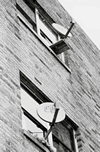
Visitors to campus this fall may have done a double-take at what one dorm resident termed “the missile defense system we have up outside the hall.”
He was talking about the growing number of student-installed satellite TV dishes jutting from the windows of residence halls, especially the men’s dorms.
The dishes have brought expanded viewing options to many campus residents, but they’ve also renewed concern about students squirreling themselves away in their rooms for hours, and about TV equipment spoiling the outward appearance of buildings.
Since 1992 all Notre Dame residence halls have been equipped with cable TV, but the cables run only to the dorm TV lounges. Students wanting to watch TV in their rooms have had to rely on rabbit ears, which limits their reception to the Michiana network affiliates.
No formal inventory has been taken of the dorm-window dishes, but a reporter on a jog around campus in early November counted more than 40.
Residents say most of the dishes serve two or three rooms so as to divide up the cost among more people. Prices of the systems vary, but owners say a typical set-up capable of serving multiple rooms runs about $100 plus $20 to $80 a month for programming, depending on choices of movie and sports channels. Ironically, the new systems offer nearly everything except the local stations.
“We got it basically because we were tired of not getting good reception,” says junior Colin Grady of Dillon Hall. “And also for the Sunday Ticket package — it’s our big thing.”
Sunday Ticket is a premium programming package that gives access to every NFL game for a flat rate of $169 a season.
Grady lives in a quad (four-resident suite) that shares its dish with another quad down the hall. The rooms are connected by cables strung through the ceiling over the hallway. He says the possibility of getting satellite TV service actually entered into his thinking during room picks last year. He wanted to get a room on the south side of the building because the dishes have to face southwest to pick up the signals.
It is being left up to individual hall rectors whether to permit the dishes, says Scott Kachmarik, director of student residences. Generally the dishes have been allowed as long as the installation doesn’t damage screens, windows or any other part of the building. In Knott Hall the dishes must be moved inside or the mounting brackets surrounded with plexiglass in winter to keep cold air out and prevent pipes from freezing. In Dillon the dishes aren’t allow to protrude at all; they have to remain inside the window at all times so as not to detract from the appearance of the gothic structure.
“The reason the University put cable in every dorm’s TV lounge was because they felt that antennae on the outside of the buildings were ugly and taking away from the outer appearance of the dorm,” Kachmarik says. “The satellite dishes are bringing us back to that same issue.”